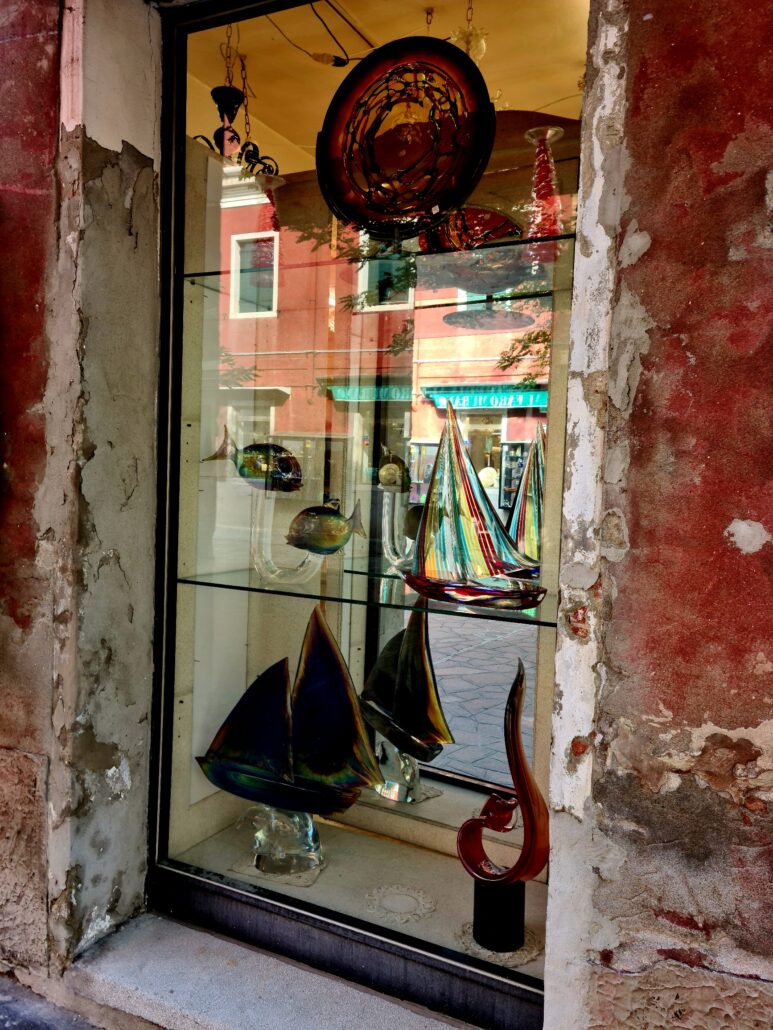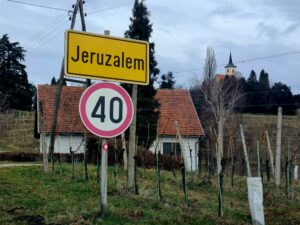Visitors to Venice are often time poor or so focused on the city and all its splendour that they neglect the islands in the Venetian lagoon. Not me.
A few years back, I stayed on Lido rather than in the city itself and enjoyed the normalcy that comes with neighbourhood living. I’d visited Burano, Murano, and San Michele before, but it was years ago and I needed a refresh.
Burano
I was in Burano in February one year and while the island’s colours were imprinted on my brain, they were muted compared to seeing them under the full blaze of a late-summer sun. They positively glowed. 
It’s almost, but not quite, too much to take in. Take that green on the right. There’s a house a couple of villages over painted the same colour and it looks horrendous. Here though, it works. We have sun too, but what we don’t have is water. Perhaps water gives you permission to be daring, different, more individual? But in their difference is there a sameness? Burano does that to me. It makes me ask questions. It’s like the UN of house facades.

Burano is known for its lace. It reminds me a little of Gozo, an island off Malta, in that regard. It was late in the day so I didn’t see any of the island’s lacemakers at their craft but there was plenty of it to buy in the tiny shops opened especially for tourists. The craft dates back to the 1500s and today the Museo del Merletto (Lace Museum) in Piazza Galuppi is housed in what was the lace school for nearly 100 years (1872-1970). As with most things Italian, there’s a story.*
A betrothed fisherman was fishing outside the lagoon, in the east sea, when he was held up by a siren who tried to entice him by her canto. Enchanted by his faithfulness the siren thumped the side of the boat with her tail, creating foam from which a wedding veil developed. On his wedding day, the fisherman gave the gift to his fiancée. She was admired and envied by all the young ladies of the island, whereupon they began to imitate the lace of the wedding veil using needles and thinner and thinner thread hoping to create an even more beautiful lace for their wedding dresses.

The creativity doesn’t stop there. I was enchanted by the door curtains and decorations, an attempt at individuality when individuality is so much it morphs into sameness. Said to have a population of 3000 or so, the island is about 45 minutes by boat from Venice.

The Tre Ponti (three bridges) is where the postcard photos are taken from. It connects three canals and three colourful streets: Giudecca, San Mauro, and San Martino Sinistro. And the bell tower you see in the photo? It really is leaning – it’s known as the leaning tower of Burano. Imaginative.

Note to self for next time
- Visit San Martino church
- Find Bepi’s House
- Visit Remigo Barbaro’s house on Via Terranova – I think I’d have liked the hermit sculptor
- Try some risotto de gò: the broth in which the rice is cooked and creamed is extracted from the gò (Goby), a fish found in the lagoon
Murano
Closer to Venice is the island of Murano, famous for its glass. Back in the thirteenth century, by order of the Doge, Venetian glassmakers had to move their fornaci (furnaces) to Murano lest a fire break out in the city. This precautionary move saw the concentration of the craft on this island (or islands). Dating to the sixth century, Murano was founded by those from Altino fleeing the Huns. Like Venice, it’s a series of islands (7) connected by bridges.


The main attraction has to be the Museo del Vetro (the Glass Museum). It grew into this speciality having spent time as a patrician’s palace, a bishop’s palace, and a town hall. Again, Malta came to mind – this time for its Mdina glass. I wasn’t all that interested in the museum. We hadn’t planned to stop in Murano; we simply needed to change boats to get to Burano. Next time, I’ll make the time – I’d like to see the 60-branch glass chandelier made by Giovanni Fuga and Lorenzo Santi that won gold at the first Murano Glass Exposition in 1864.
Most of the shops sell Murano glass with varying degrees of sophistication. Even here though, it’s important to check that what you’re buying was REALLY made on the island and not imported. I found that sad. Watch for the stickers that certify the shop is selling the real thing and not some Chinese knock-off.



I am gutted that I missed the seventh-century Basilica of Saint Mary and Saint Donatus. I didn’t even see it, so focused was I on getting a coffee in and out of me before the boat for Burano departed. Next time, definitely. I want to see the floor made from Byzantine mosaics and the metre-long rib bones behind the altar said to be from a dragon slain by St Donatus in Greece. And I missed the Tintoretto in the Roman Catholic Church of Saint Peter the Martyr and Simone Cenedese’s Comet Glass Star.
Sure, I wasn’t there at all! Maybe next time I’ll make Murano my base and plump for the Hyatt in Murano.
I hadn’t noticed the lighthouse until I saw this photo. Cmon, who’d expect a lighthouse when you’re not near the sea-sea? Apparently, though, it’s there to light up the lagoon. Lord knows how I missed it or where my head was that day!

Note to self for next time
- Basilica of Saint Mary and Saint Donatus
- Church of Saint Peter the Martyr
- Simone Cenedese’s Comet Glass Star
Hoards of people take the Vaporetto from Venice to the islands; others take one of the day tours that run from St Lucia train station to the islands of Burano, Murano, and Torcello. With a boat tour, you’re guaranteed a seat. If the Vaporetto is packed (and they usually are), you could be standing most of the way. A two-day Vaporetto ticket will set you back €30. But with it, you get the freedom to go anywhere. Just hop on a boat and see where it takes you. If you have time. We didn’t. I had to choose.
* I translated the translation, ’cause that’s what I do
Share this:
- Click to share on Twitter (Opens in new window)
- Click to share on Facebook (Opens in new window)
- Click to share on Pinterest (Opens in new window)
- Click to share on LinkedIn (Opens in new window)
- Click to share on Reddit (Opens in new window)
- Click to share on WhatsApp (Opens in new window)
- Click to share on Pocket (Opens in new window)
- Click to share on Telegram (Opens in new window)
- Click to email a link to a friend (Opens in new window)








2 Responses
You’ve captured the joy and anguish of traveling beautifully. We are immersed in and touched by in the places we see and haunted by all that we’ve missed.
knowing that there might not always be a next time …